Civilizations
throughout the ages have found ingenious ways to combat the heat in their
region. An earlier form of air cooling, the windcatcher,
was invented in Persia (Iran) thousands of years ago in the form of wind shafts on the
roof, which caught the wind, passed it over subterranean water in a qanat and
discharged the cooled air into the building.
A windcatcher is a traditional Persian architectural element to
create natural ventilation in buildings. Windcatchers
come in various designs: uni-directional, bi-directional, and
multi-directional. Windcatchers remain present in many countries and can be
found in traditional Persian-influenced architecture throughout the Middle East, including in the small Arab states of the Persian Gulf (mostly
Bahrain and Dubai), Pakistan and Afghanistan.
 |
| Schematic diagram of an ancient Iranian windcatcher and qanat, used for evaporative cooling of buildings |
The swamp cooler was the subject of numerous US United States

